check engine MAZDA 626 1987 Workshop Manual
[x] Cancel search | Manufacturer: MAZDA, Model Year: 1987, Model line: 626, Model: MAZDA 626 1987Pages: 1865, PDF Size: 94.35 MB
Page 500 of 1865

4B IDLE-UP SYSTEM
AIR VALVE
Pre-inspection
1. Start the engine and run it at idle.
2. Pinch the bypass air hose and check that the en-
gine rpm drops.
When engine still cool RPM reduced
After warming-up RPM drop within
200 rpm
3. If the speed is not reduced when cold, check the
air valve, or check for vacuum leaks at the bypass
air hose.
4. If the speed drop is more than 200 rpm when
warm, check the air valve and current to the valve.
Inspection of Terminal Voltage
1. Disconnect the connector from the valve.
2. Remove the rubber boot from the connector.
3. Start the engine and run it at idle.
4. Check that there is battery voltage at terminal (WY),
using a voltmeter.
5. If not correct, check the circuit opening relay and
wiring harness.
76G04B-046
Inspection of Air Valve
1. Check the valve for operation.
Temperature 20°C (68°F) Valve open
(When engine cool)
After warming-up Valve closed
2. Replace valve if faulty.
76G04B-047
4B—38 expert22 Arm http://rutracker.org
Page 501 of 1865
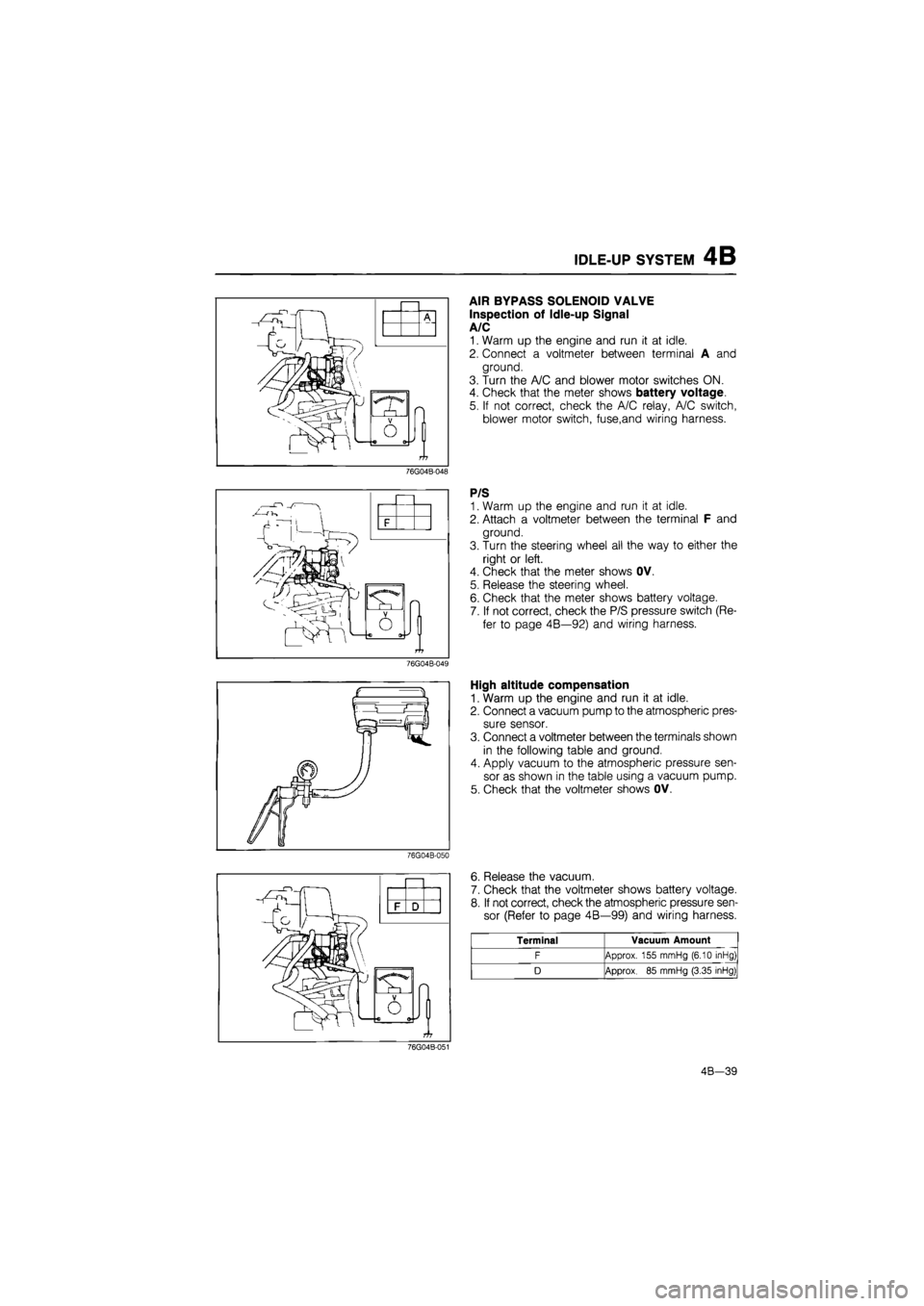
IDLE-UP SYSTEM 4B
AIR BYPASS SOLENOID VALVE
Inspection of Idle-up Signal
A/C
1. Warm up the engine and run it at idle.
2. Connect a voltmeter between terminal A and
ground.
3. Turn the A/C and blower motor switches ON.
4. Check that the meter shows battery voltage.
5. If not correct, check the A/C relay, A/C switch,
blower motor switch, fuse,and wiring harness.
76G04B-048
P/S
1. Warm up the engine and run it at idle.
2. Attach a voltmeter between the terminal F and
ground.
3. Turn the steering wheel all the way to either the
right or left.
4. Check that the meter shows OV.
5. Release the steering wheel.
6. Check that the meter shows battery voltage.
7. If not correct, check the P/S pressure switch (Re-
fer to page 4B—92) and wiring harness.
76G04B-049
High altitude compensation
1. Warm up the engine and run it at idle.
2. Connect a vacuum pump to the atmospheric pres-
sure sensor.
3. Connect a voltmeter between the terminals shown
in the following table and ground.
4. Apply vacuum to the atmospheric pressure sen-
sor as shown in the table using a vacuum pump.
5. Check that the voltmeter shows OV.
76G04B-050
J
O
6. Release the vacuum.
7. Check that the voltmeter shows battery voltage.
8. If not correct, check the atmospheric pressure sen-
sor (Refer to page 4B—99) and wiring harness.
Terminal Vacuum Amount
F Approx. 155 mmHg (6.10 inHg)
D Approx.
85
mmHg (3.35 inHg)
76G04B-051
4B-39
Page 502 of 1865
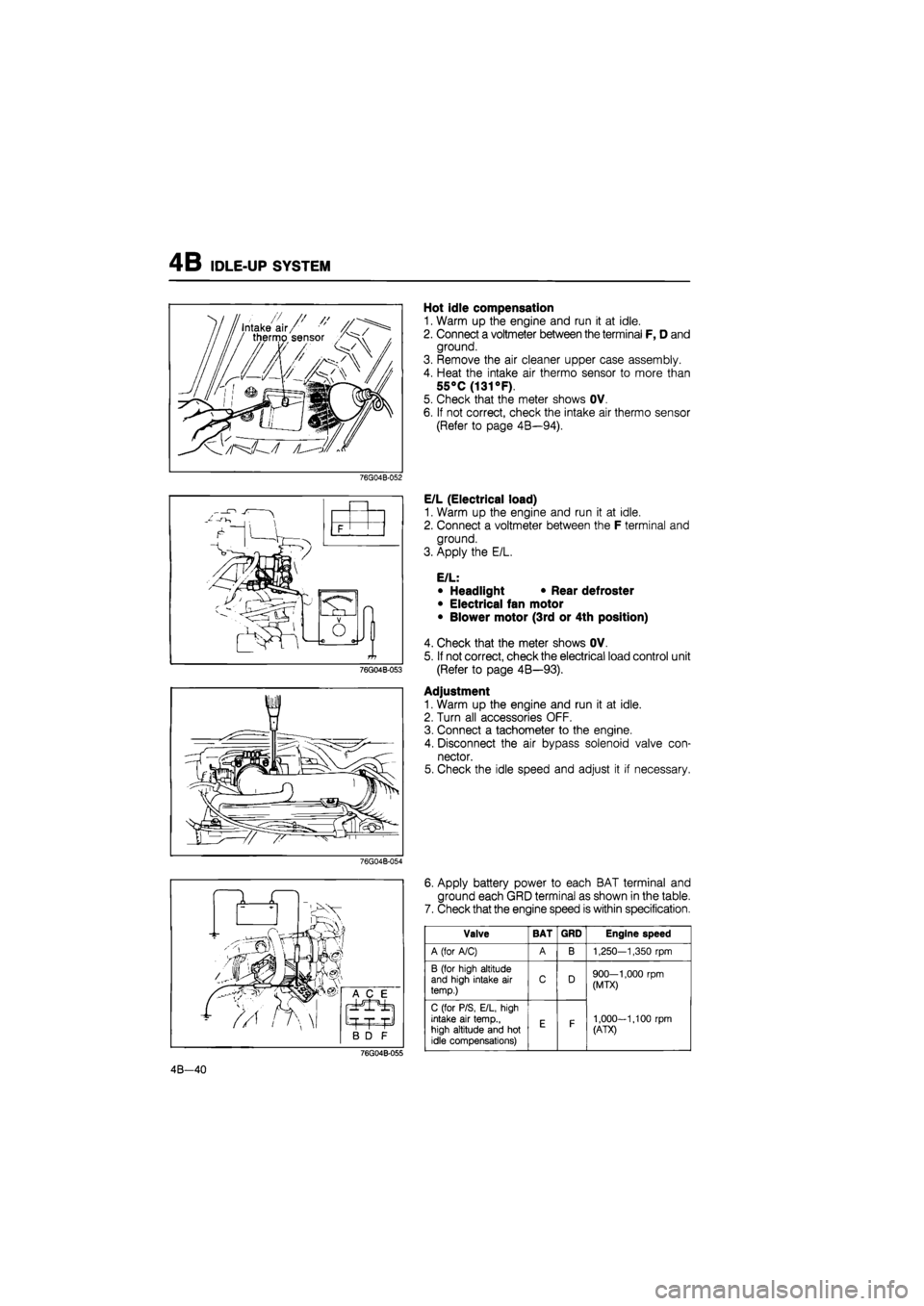
4B IDLE-UP SYSTEM
76G04B-052
76G04B-053
76G04B-054
Hot idle compensation
1. Warm up the engine and run it at idle.
2. Connect a voltmeter between the terminal F, D and
ground.
3. Remove the air cleaner upper case assembly.
4. Heat the intake air thermo sensor to more than
55°C
(131
°F).
5. Check that the meter shows OV.
6. If not correct, check the intake air thermo sensor
(Refer to page 4B—94).
E/L (Electrical load)
1. Warm up the engine and run it at idle.
2. Connect a voltmeter between the F terminal and
ground.
3. Apply the E/L.
E/L:
• Headlight • Rear defroster
• Electrical fan motor
• Blower motor (3rd or 4th position)
4. Check that the meter shows OV.
5. If not correct, check the electrical load control unit
(Refer to page 4B—93).
Adjustment
1. Warm up the engine and run it at idle.
2. Turn all accessories OFF.
3. Connect a tachometer to the engine.
4. Disconnect the air bypass solenoid valve con-
nector.
5. Check the idle speed and adjust it if necessary.
6. Apply battery power to each BAT terminal and
ground each GRD terminal as shown in the table.
7. Check that the engine speed is within specification.
76G04B-055
Valve BAT GRD Engine speed
A (for A/C) A B 1,250—1,350
rpm
B (for high altitude and high intake
air
temp.) C D 900—1,000
rpm
(MTX)
1,000-1,100
rpm
(ATX)
C (for P/S, E/L, high intake
air
temp., high altitude and
hot
idle compensations)
E F
900—1,000
rpm
(MTX)
1,000-1,100
rpm
(ATX)
4B—40
Page 506 of 1865
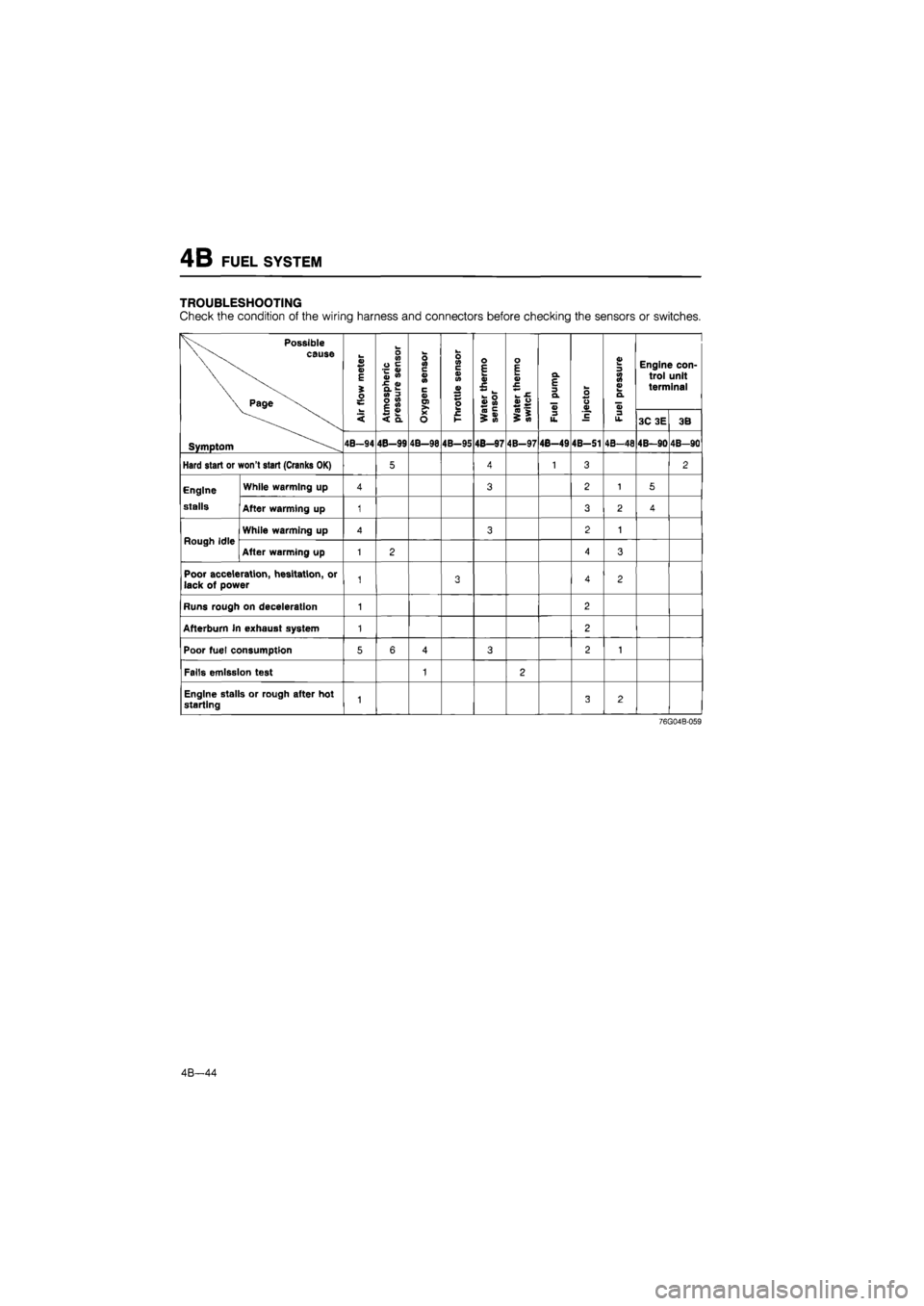
4B FUEL SYSTEM
TROUBLESHOOTING
Check
the
condition
of
the wiring harness and connectors before checking
the
sensors
or
switches.
Possible
cause
Page
V
S E
i
o
o V)
0
e
~
0)
Ju
»
•E
<»
CL
01
3
0
<0
1
£
Oxygen
sensor
s c V
in
V
P
o E k_
•E **
l_
h
O
v
w
Water
thermo
switch
Q.
E
3 Q.
u
Injector
£ 3 3 o d
aj
Engine
con-
trol unit terminal
< £
8
<
Q. Oxygen
sensor
£ t->
0)
>
M Water
thermo
switch
3
u.
Injector
3
u. 3C
3E
3B
Symptom 4B-94 4B-99 4B—98 4B-95 48—97 4B-97 4B-49 4B-S1 4B-48 4B-90 4B-90
Hard start
or
won't start (Cranks
OK)
5 4 1 3 2
Engine While warming
up
4 3 2 1 5
stalls After warming
up
1 3 2 4
Rough Idle While warming
up
4 3 2 1
Rough Idle After warming
up
1 2 4 3
Poor acceleration, hesitation,
or
lack
of
power
1 3 4 2
Runs rough
on
deceleration
1 2
Afterburn
in
exhaust system
1 2
Poor fuel consumption
5 6 4 3 2 1
Falls emission test
1 2
Engine stalls
or
rough after
hot
starting
1 3 2
76G04B-059
4B—44
Page 510 of 1865
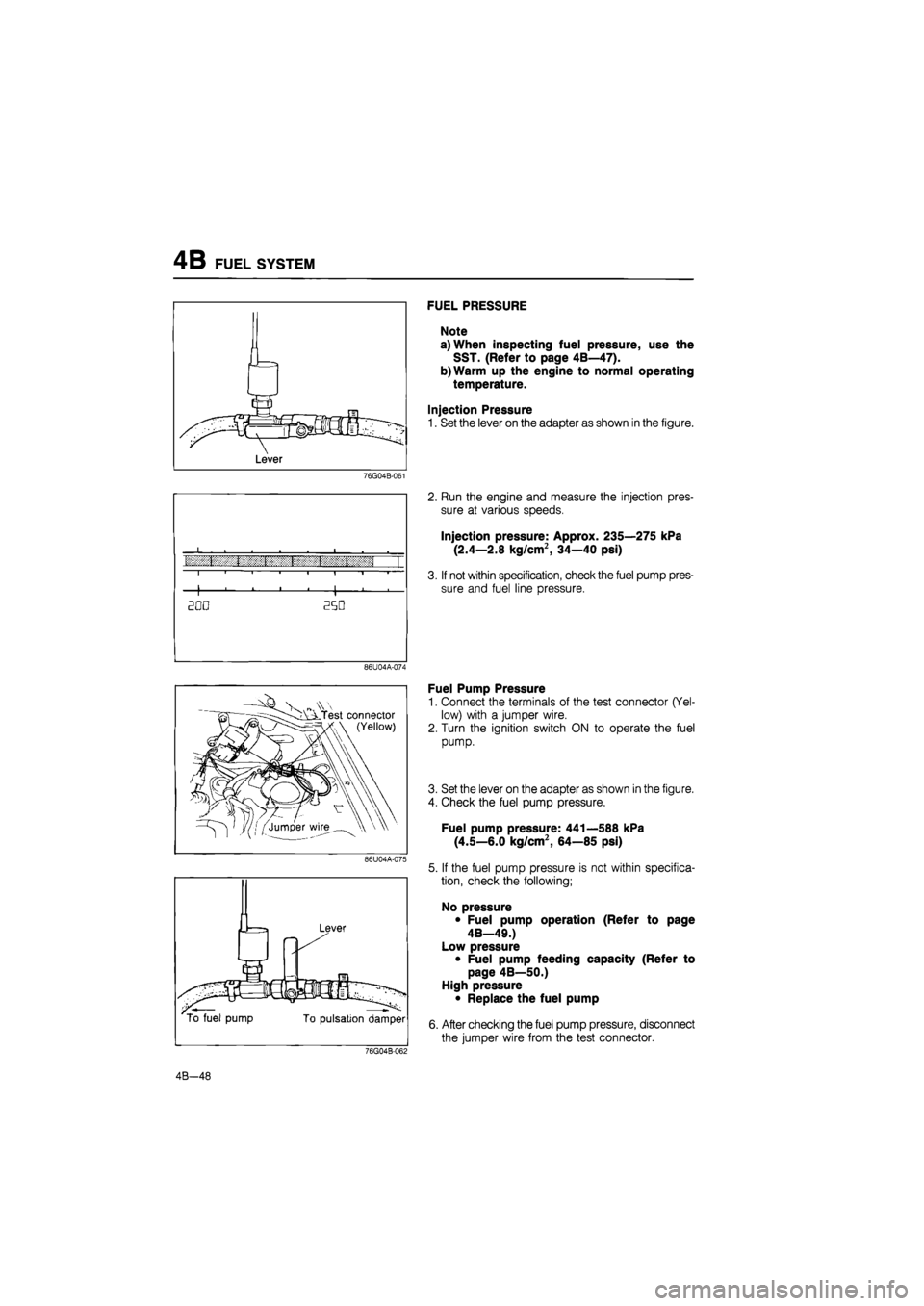
4B FUEL SYSTEM
76G04B-061
I i. i { 1 t' i 1 I • i i 1 1 "1 —r
1 . . • , 1 ,
EDO 250
86U04A-074
w Test connector
(Yellow)
86U04A-075
Lever
To fuel pump To pulsation damper
FUEL PRESSURE
Note
a) When inspecting fuel pressure, use the
SST. (Refer to page 4B—47).
b)Warm up the engine to normal operating
temperature.
Injection Pressure
1. Set the lever on the adapter as shown in the figure.
2. Run the engine and measure the injection pres-
sure at various speeds.
Injection pressure: Approx. 235—275 kPa
(2.4—2.8 kg/cm2, 34—40 psi)
3. If not within specification, check the fuel pump pres-
sure and fuel line pressure.
Fuel Pump Pressure
1. Connect the terminals of the test connector (Yel-
low) with a jumper wire.
2. Turn the ignition switch ON to operate the fuel
pump.
3. Set the lever on the adapter as shown in the figure.
4. Check the fuel pump pressure.
Fuel pump pressure: 441—588 kPa
(4.5—6.0 kg/cm2, 64—85 psi)
5. If the fuel pump pressure is not within specifica-
tion, check the following;
No pressure
• Fuel pump operation (Refer to page
4B—49.)
Low pressure
• Fuel pump feeding capacity (Refer to
page 4B—50.)
High pressure
• Replace the fuel pump
6. After checking the fuel pump pressure, disconnect
the jumper wire from the test connector.
76G04B-062
4B—48
Page 511 of 1865
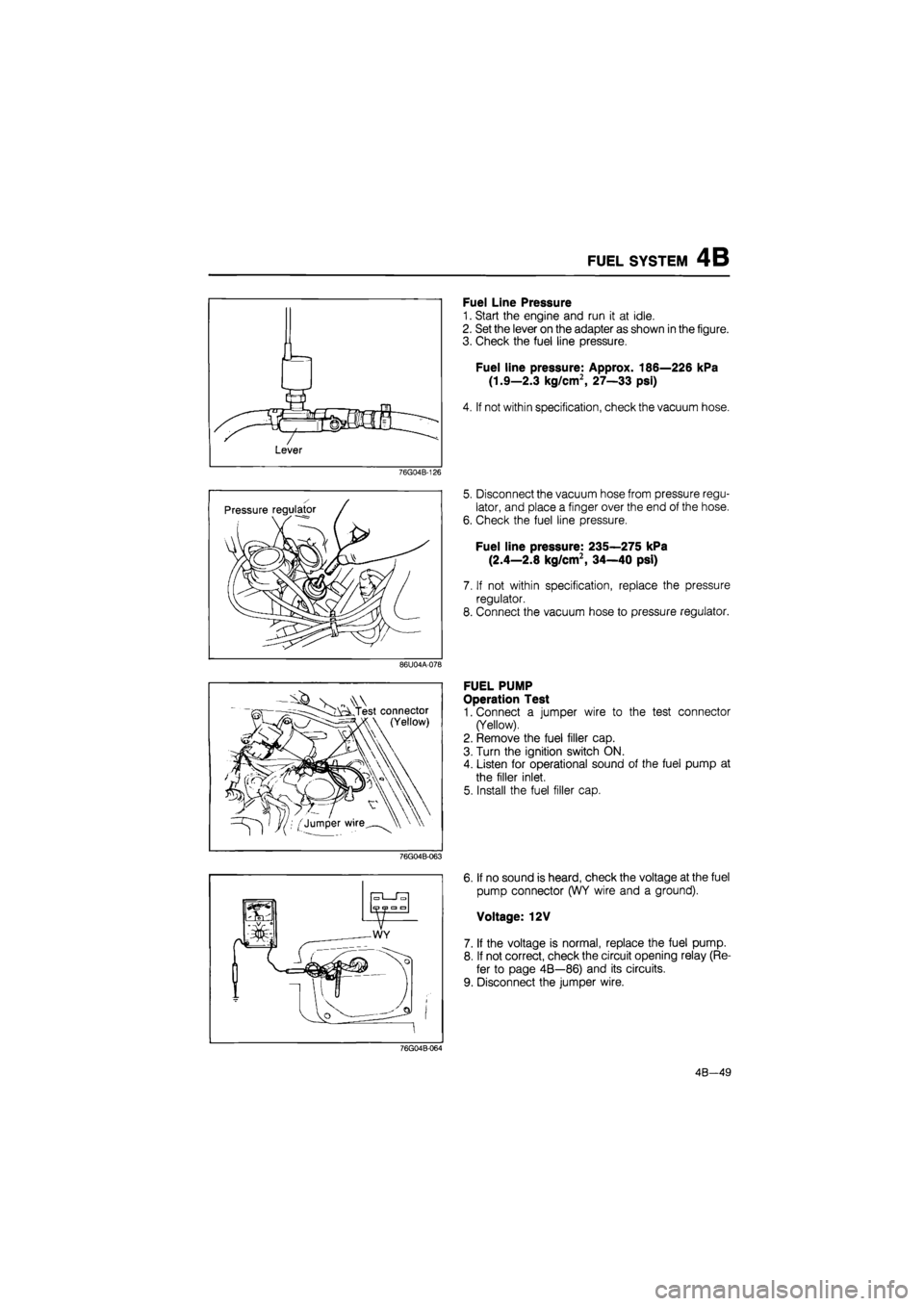
FUEL SYSTEM 4B
76G04B-126
86U04A-078
V^AN.
- Test connector
(Yellow)
76G04B-063
Fuel Line Pressure
1. Start the engine and run it at idle.
2. Set the lever on the adapter as shown in the figure.
3. Check the fuel line pressure.
Fuel line pressure: Approx. 186—226 kPa
(1.9—2.3 kg/cm2, 27—33 psi)
4. If not within specification, check the vacuum hose.
5. Disconnect the vacuum hose from pressure regu-
lator, and place a finger over the end of the hose.
6. Check the fuel line pressure.
Fuel line pressure: 235—275 kPa
(2.4—2.8 kg/cm2, 34—40 psi)
7. If not within specification, replace the pressure
regulator.
8. Connect the vacuum hose to pressure regulator.
FUEL PUMP
Operation Test
1. Connect a jumper wire to the test connector
(Yellow).
2. Remove the fuel filler cap.
3. Turn the ignition switch ON.
4. Listen for operational sound of the fuel pump at
the filler inlet.
5. Install the fuel filler cap.
6. If no sound is heard, check the voltage at the fuel
pump connector (WY wire and a ground).
Voltage: 12V
7. If the voltage is normal, replace the fuel pump.
8. If not correct, check the circuit opening relay (Re-
fer to page 4B—86) and its circuits.
9. Disconnect the jumper wire.
76G04B-064
4B—49
Page 512 of 1865
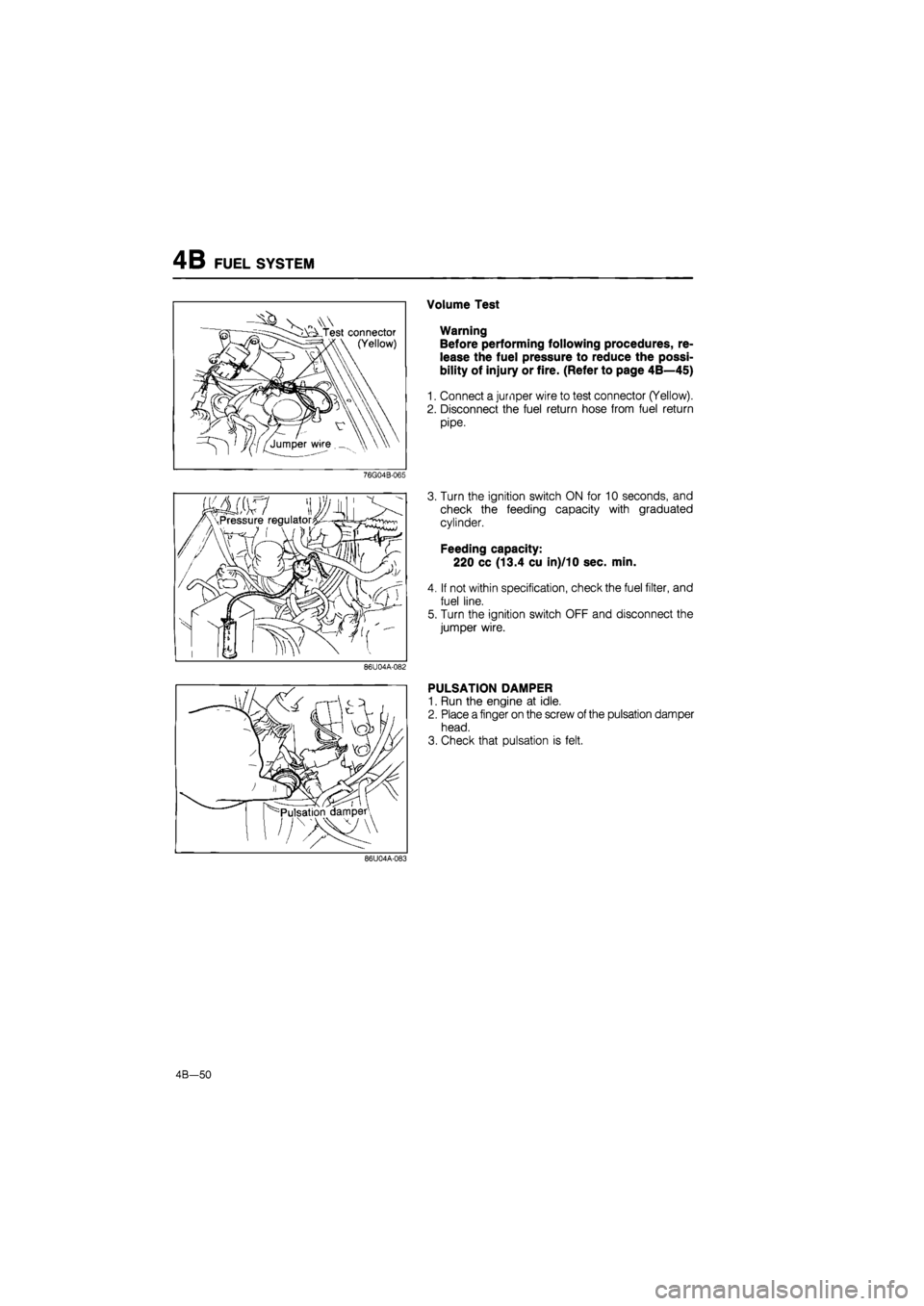
4B FUEL SYSTEM
Volume Test
Warning
Before performing following procedures, re-
lease the fuel pressure to reduce the possi-
bility of injury or fire. (Refer to page 4B—45)
1. Connect a jumper wire to test connector (Yellow).
2. Disconnect the fuel return hose from fuel return
pipe.
76G04B-065
3. Turn the ignition switch ON for 10 seconds, and
check the feeding capacity with graduated
cylinder.
Feeding capacity:
220 cc (13.4 cu in)/10 sec. min.
4. If not within specification, check the fuel filter, and
fuel line.
5. Turn the ignition switch OFF and disconnect the
jumper wire.
86U04A-082
PULSATION DAMPER
1. Run the engine at idle.
2. Place a finger on the screw of the pulsation damper
head.
3. Check that pulsation is felt.
86U04A-083
4B—50
Page 513 of 1865
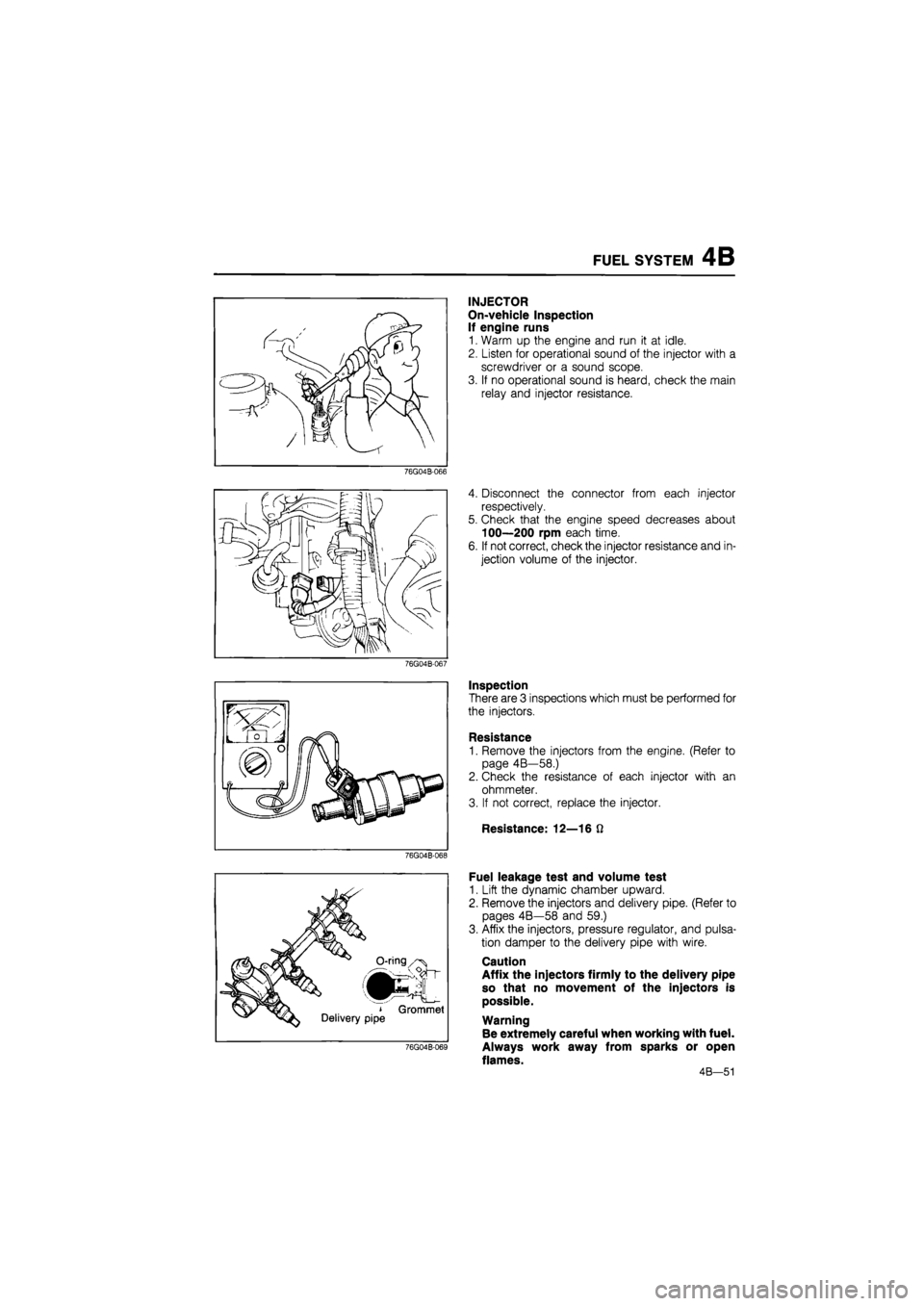
FUEL SYSTEM 4B
INJECTOR
On-vehicle Inspection
If engine runs
1. Warm up the engine and run it at idle.
2. Listen for operational sound of the injector with a
screwdriver or a sound scope.
3. If no operational sound is heard, check the main
relay and injector resistance.
76G04B-066
4. Disconnect the connector from each injector
respectively.
5. Check that the engine speed decreases about
100—200 rpm each time.
6. If not correct, check the injector resistance and in-
jection volume of the injector.
76G04B-067
Inspection
There are 3 inspections which must be performed for
the injectors.
Resistance
1. Remove the injectors from the engine. (Refer to
page 4B—58.)
2. Check the resistance of each injector with an
ohmmeter.
3. If not correct, replace the injector.
Resistance: 12—16 ft
76G04B-068
' Grommet Delivery pipe
76G04B-069
Fuel leakage test and volume test
1. Lift the dynamic chamber upward.
2. Remove the injectors and delivery pipe. (Refer to
pages 4B—58 and 59.)
3. Affix the injectors, pressure regulator, and pulsa-
tion damper to the delivery pipe with wire.
Caution
Affix the injectors firmly to the delivery pipe
so that no movement of the injectors is
possible.
Warning
Be extremely careful when working with fuel.
Always work away from sparks or open
flames.
4B—51
Page 517 of 1865
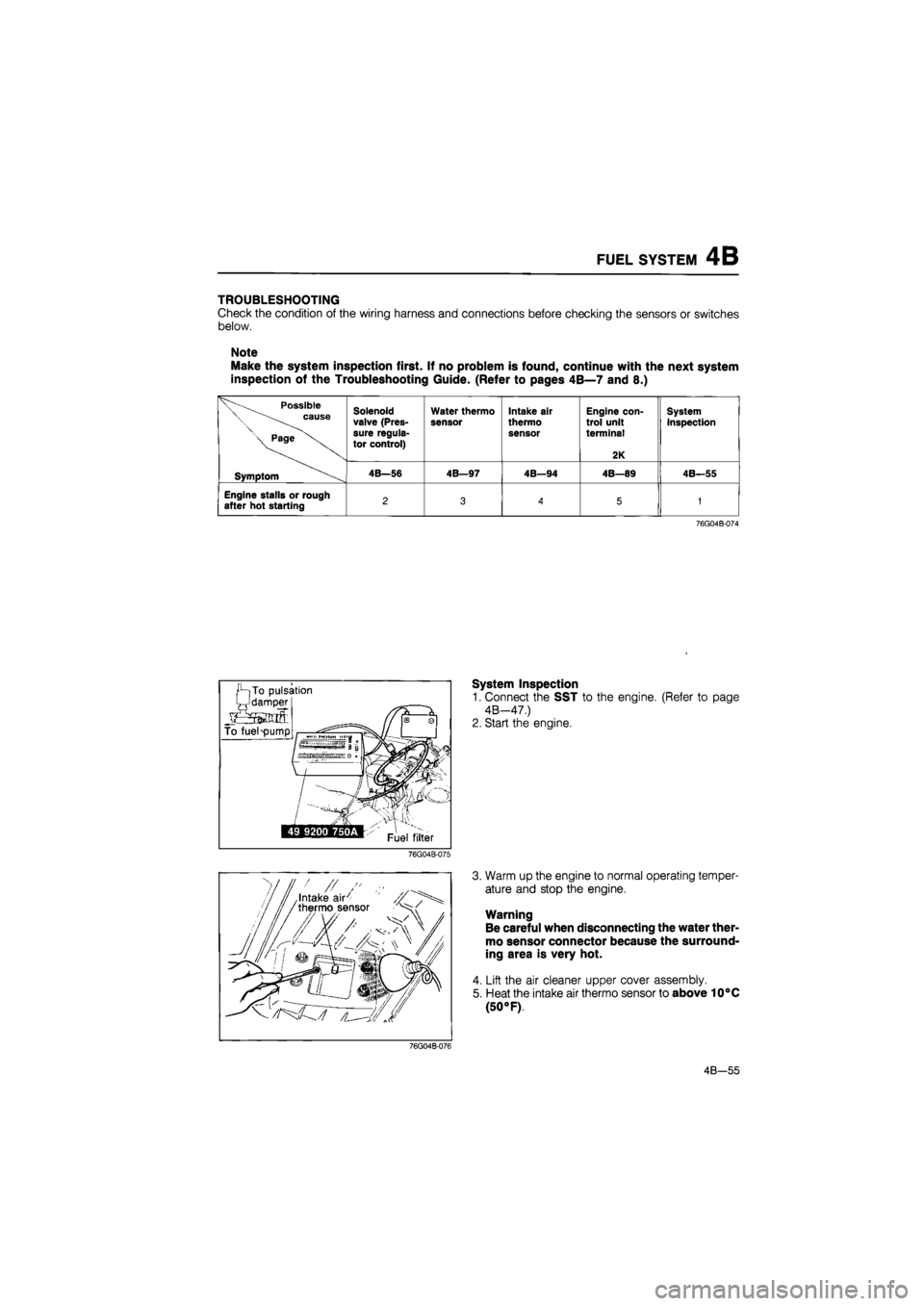
FUEL SYSTEM 4B
TROUBLESHOOTING
Check the condition of the wiring harness and connections before checking the sensors or switches
below.
Note
Make the system inspection first. If no problem is found, continue with the next system
inspection of the Troubleshooting Guide. (Refer to pages 4B—7 and 8.)
Possible \ cause
\ Page
Solenoid valve (Pres-sure regula-tor control)
Water thermo
sensor Intake air
thermo sensor
Engine con-trol unit terminal
2K
System inspection
Symptom 4B—56 4B—97 4B—94 4B—89 4B—55
Engine stalls or rough after hot starting 2 3
A
5 1
76G04B-074
System Inspection
1. Connect the SST to the engine. (Refer to page
4B—47.)
2. Start the engine.
76G04B-075
3. Warm up the engine to normal operating temper-
ature and stop the engine.
Warning
Be careful when disconnecting the water ther-
mo sensor connector because the surround-
ing area is very hot.
4. Lift the air cleaner upper cover assembly.
5. Heat the intake air thermo sensor to above 10°C
(50 °F).
76G04B-076
4B—55
Page 518 of 1865
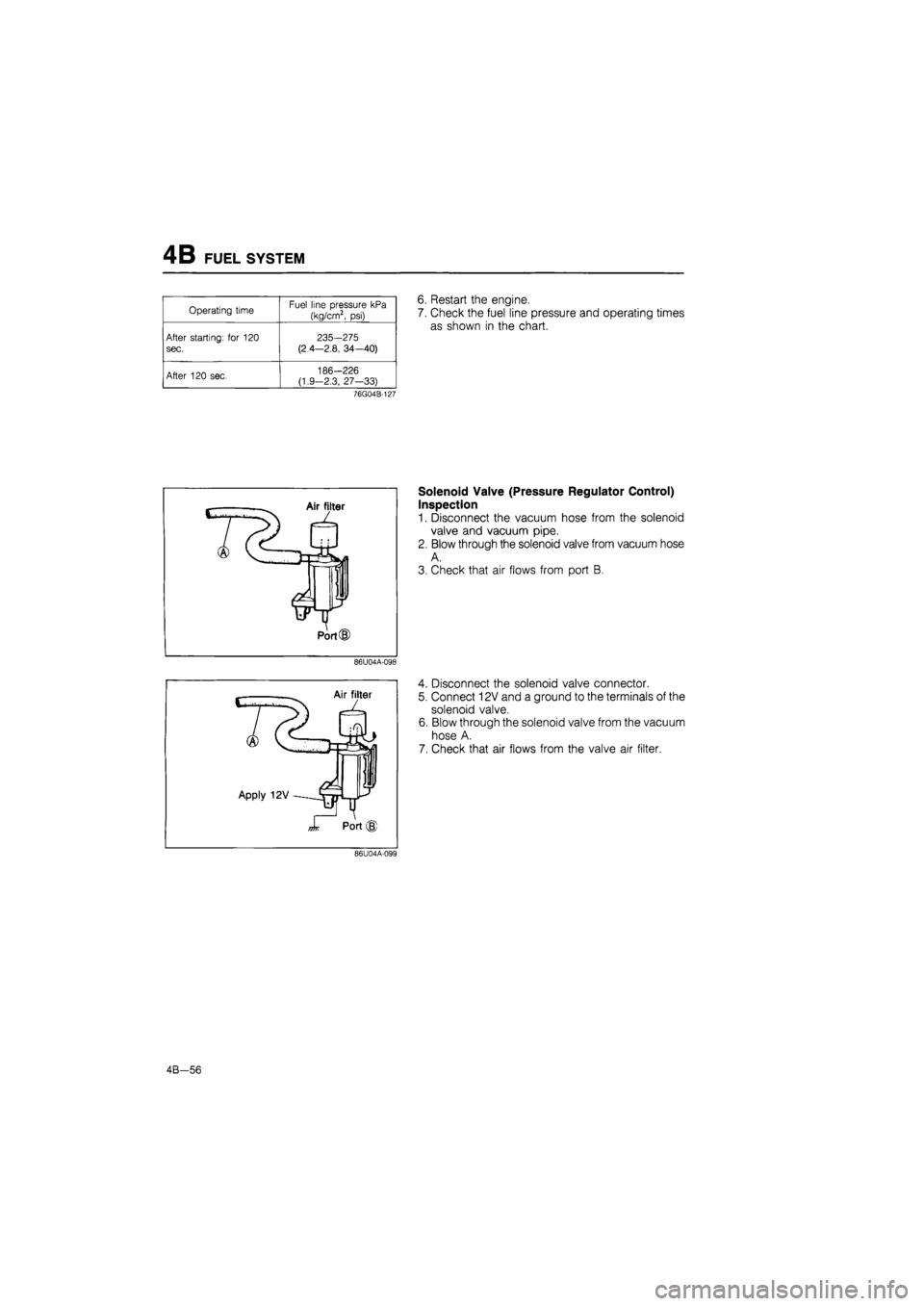
4B FUEL SYSTEM
Operating time Fuel line pressure kPa
(kg/cm2, psi)
After starting: for 120
sec.
235-275
(2.4—2.8, 34—40)
After 120 sec, 186-226 (1.9-2.3, 27-33)
6. Restart the engine.
7. Check the fuel line pressure and operating times
as shown in the chart.
76G04B-127
Solenoid Valve (Pressure Regulator Control)
Inspection
1. Disconnect the vacuum hose from the solenoid
valve and vacuum pipe.
2. Blow through the solenoid valve from vacuum hose
A.
3. Check that air flows from port B.
86U04A-098
Air filter
Apply 12V
Port (J)
4. Disconnect the solenoid valve connector.
5. Connect 12V and a ground to the terminals of the
solenoid valve.
6. Blow through the solenoid valve from the vacuum
hose A.
7. Check that air flows from the valve air filter.
86U04A-099
4B-56